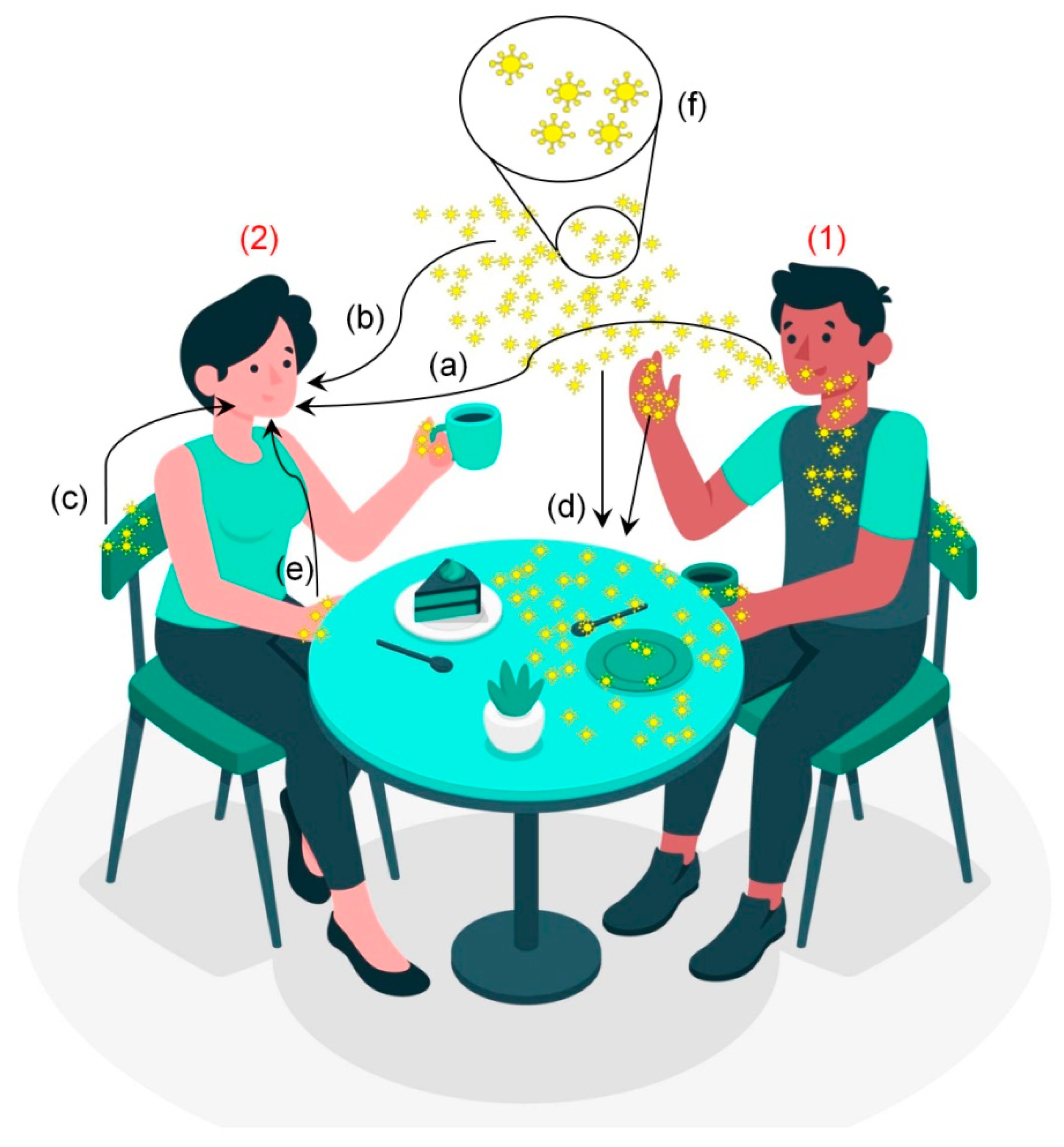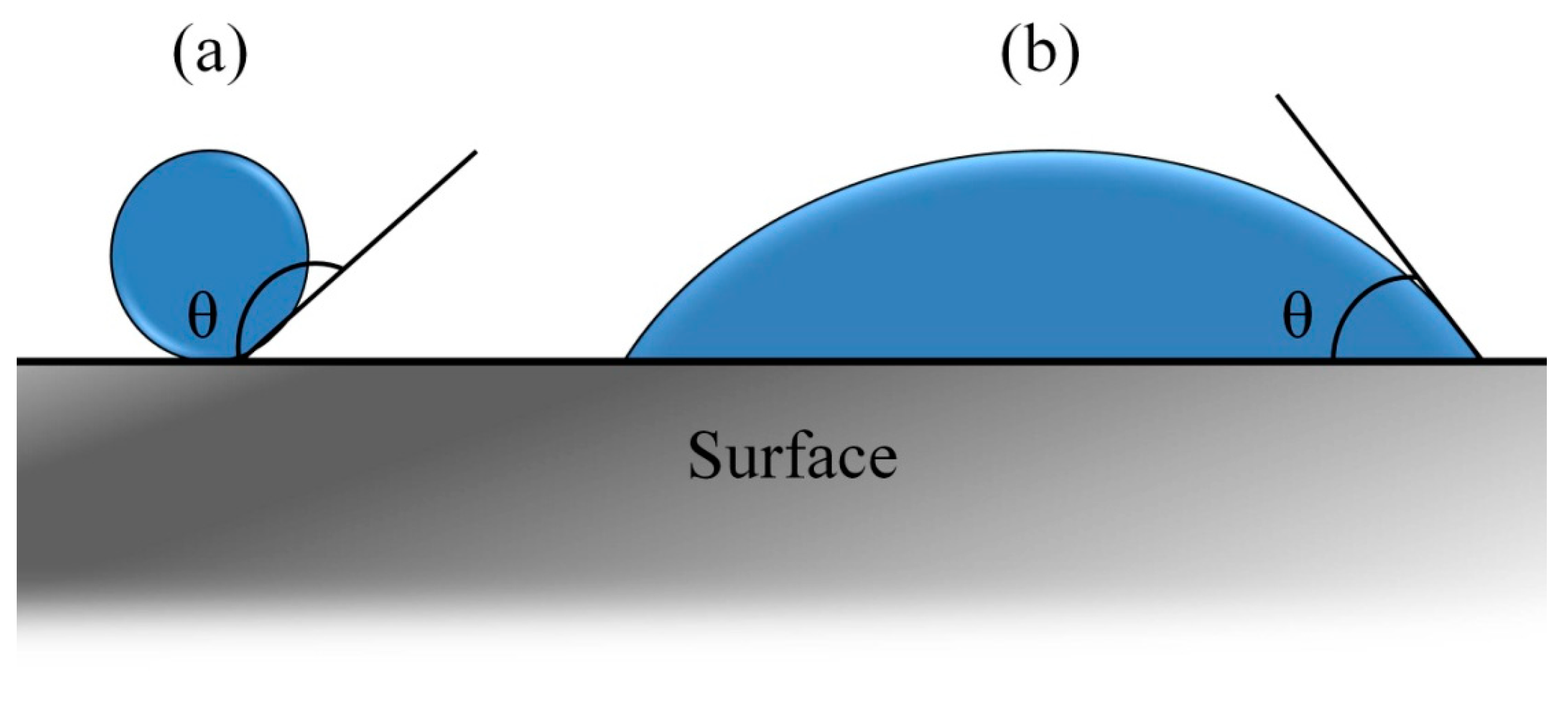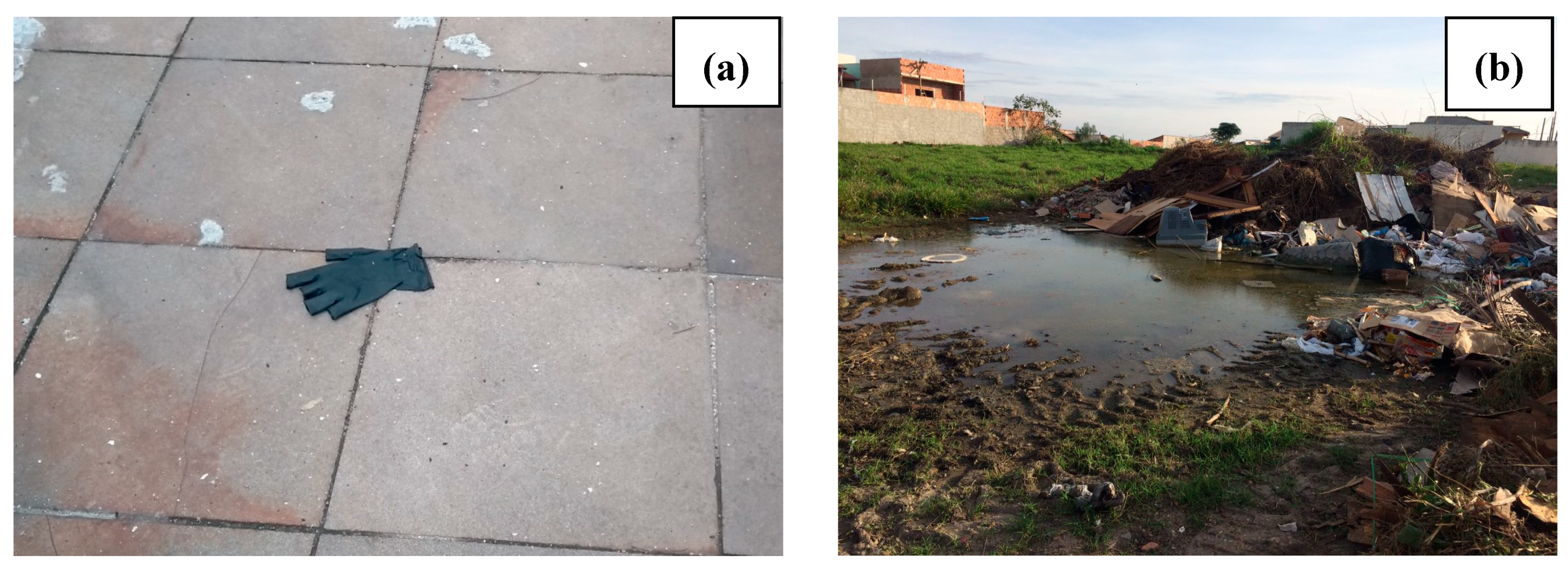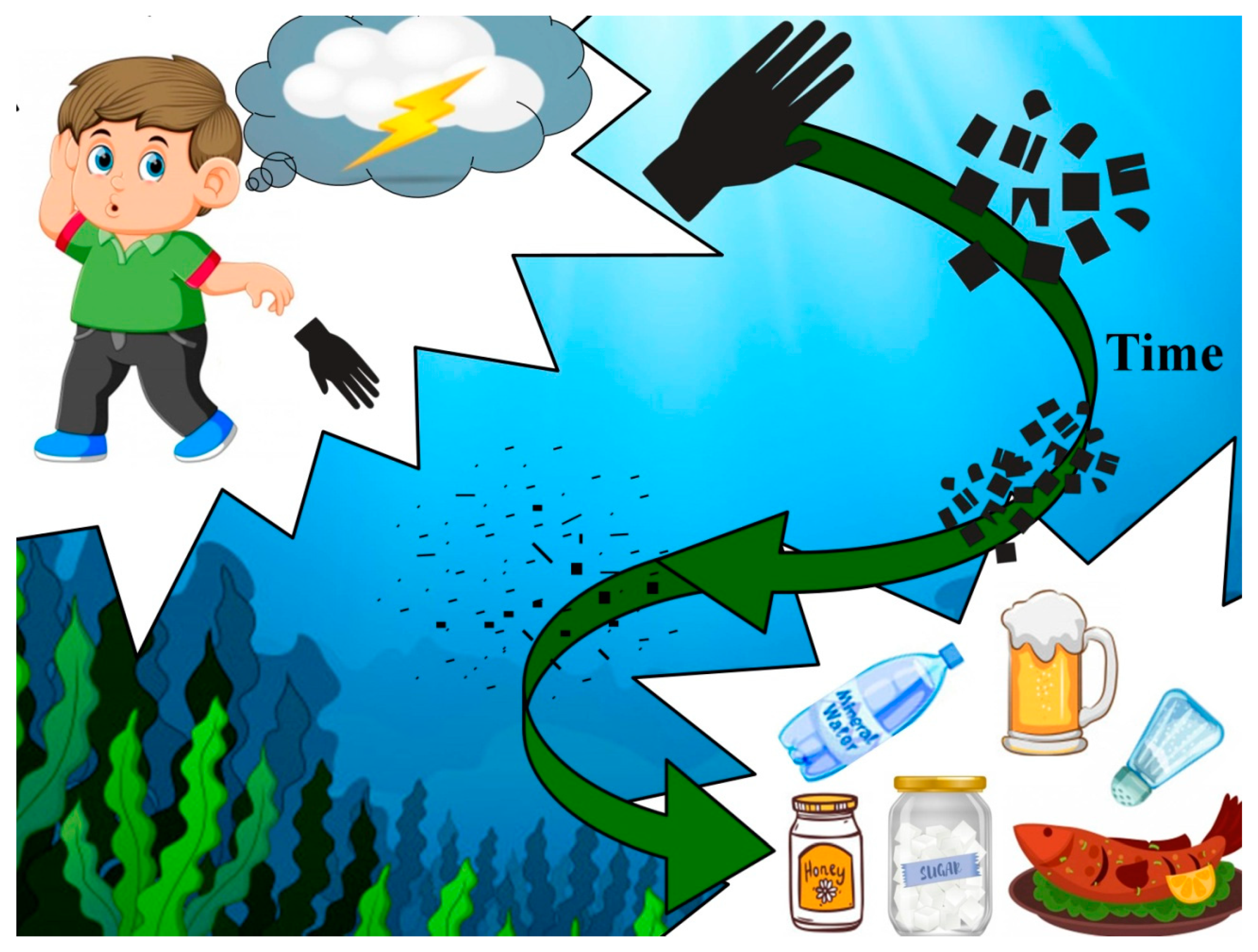Pros and Cons of Plastic during the COVID-19 Pandemic
Abstract
1. Introduction
2. COVID-19
3. The Role of Plastic in the Pandemic Scenario
3.1. The Role of Plastic at Home
3.2. The Role of Plastic in Hospitals
4. Socio-Environmental Problems Caused by Plastic
5. Recycling of Plastic during the Pandemic
6. Discussion
- -
- “The industry is also noticing that consumers’ view of plastic packaging has changed during the crisis. The function of the packaging, i.e., the hygiene and protection of the product, is being perceived more strongly again. We hope that this contributes to a more objective discussion about plastic packaging in the future”, said the IK (Industrievereinigung Kunststoffverpackungen) General Director Dr. Martin Engelmann to the survey [82].
- -
- “We have been reminded of the value these materials bring. After we have recovered, we should focus our efforts on truly fixing our broken waste management system instead of banning valuable products in a futile attempt to adapt to it”, said Ineos [88].
- -
- As said by Antonis Mavropoulos, president of ISWA:”I think the first thing we have to conclude is that single-use and easy disposability has become a massive trend again in this period, probably in a way, canceling efforts of many years to reduce single-use packaging” [79].
- -
- According to The International Union for Conservation of Nature (IUCN) [54], recycling and reuse of plastic products, and support for research and innovation to develop new products to replace single-use plastics are necessary to prevent and reduce plastic pollution.
- -
- According to Zambrano-Monserrate [53], “the virus crisis brings other environmental problems that may last longer and maybe more challenging to manage if countries neglect the impact of the epidemic on the environment”.
- -
- “We can build back better and emerge from the current crisis stronger and more resilient than ever—but to do so means choosing policies and actions that protect the nature—so that nature can help to protect us”, according to IPBES [46].
- -
- “People’s safety should come before profits”, said Greenpeace [99].
7. Conclusions
Funding
Acknowledgments
Conflicts of Interest
References
- Balakrishnan, P.; Sreekala, M.S. Recycling of plastic. In Recycling of Polymers: Methods, Characterization and Applications; Francis, R., Ed.; Wiley: Weinheim, Germany, 2017. [Google Scholar]
- Callister, W.D. Materials Science and Engineering: An Introtuction; John Wiley & Sons: New York, NY, USA, 2016. [Google Scholar]
- Sun, P.; Lu, X.; Xu, C.; Sun, W.; Pan, B. Understanding of COVID-19 based on current evidence. J. Med. Virol. 2020, 92, 548–551. [Google Scholar] [CrossRef]
- Zhu, N.; Zhang, D.; Wang, W.; Li, X.; Yang, B.; Song, J.; Zhao, X.; Huang, B.; Shi, W.; Lu, R.; et al. A novel coronavirus from patients with pneumonia in China, 2019. N. Engl. J. Med. 2020, 382, 727–733. [Google Scholar] [CrossRef]
- Statement on the Second Meeting of the International Health Regulations (2005) Emergency Committee Regarding the Outbreak of Novel Coronavirus (2019-nCoV). Available online: https://www.who.int/news-room/detail/30-01-2020-statement-on-the-second-meeting-of-the-international-health-regulations-(2005)-emergency-committee-regarding-the-outbreak-of-novel-coronavirus-(2019-ncov) (accessed on 12 April 2020).
- WHO Director-General’s Opening Remarks at the Media Briefing on COVID-19—11 March 2020. Available online: https://www.who.int/dg/speeches/detail/who-director-general-s-opening-remarks-at-the-media-briefing-on-covid-19---11-march-2020 (accessed on 12 April 2020).
- U.S. Department of Health & Human Services Centers for Disease Control and Prevention. Available online: https://www.cdc.gov/coronavirus/2019-ncov/faq.html#Preparing-Your-Home-and-Family-for-COVID-19 (accessed on 10 April 2020).
- Duguid, J.P. The size and the duration of air-carriage of respiratory droplets and droplet-nuclei. J. Hyg. (Lond.) 1946, 44, 471–479. [Google Scholar] [CrossRef]
- Papineni, R.S.; Rosenthal, F.S. The size distribution of droplets in the exhaled breath of healthy human subjects. J. Aerosol. Med. 1997, 10, 105–116. [Google Scholar] [CrossRef]
- Asadi, S.; Wexler, A.S.; Cappa, C.D.; Barreda, S.; Bouvier, N.M.; Ristenpart, W.D. Aerosol emission and superemission during human speech increase with voice loudness. Sci. Rep. 2019, 9, 2348. [Google Scholar] [CrossRef] [PubMed]
- Leung, N.H.L.; Chu, D.K.W.; Shiu, E.Y.C.; Chan, K.-H.; McDevitt, J.J.; Hau, B.J.P.; Yen, H.-L.; Li, Y.; Ip, D.K.M.; Peiris, J.S.M.; et al. Respiratory virus shedding in exhaled breath and efficacy of face masks. Nat. Med. 2020, 26, 676–680. [Google Scholar] [CrossRef] [PubMed]
- Q&A on Coronaviruses—World Health Organization. Available online: https://www.who.int/news-room/q-a-detail/q-a-coronaviruses (accessed on 11 April 2020).
- Asadi, S.; Bouvier, N.; Wexler, A.S.; Ristenpart, W.D. The coronavirus pandemic and aerosols: Does COVID-19 transmit via expiratory particles? Aerosol Sci. Technol. 2020, 1–4. [Google Scholar] [CrossRef] [PubMed]
- Coronavirus Disease (COVID-19). U.S. Department of Agriculture. Available online: https://www.usda.gov/coronavirus (accessed on 11 April 2020).
- Nikolich-Zugich, J.; Knox, K.S.; Rios, C.T.; Natt, B.; Bhattacharya, D.; Fain, M.J. SARS-CoV-2 and COVID-19 in older adults: What we may expect regarding pathogenesis, immune responses, and outcomes. GeroScience 2020, 42, 505–514. [Google Scholar] [CrossRef] [PubMed]
- Ong, S.W.X.; Tan, Y.K.; Chia, P.Y.; Lee, T.H.; Ng, O.T.; Wong, M.S.Y.; Marimuthu, K. Air, surface environmental, and personal protective equipment contamination by severe acute respiratory syndrome Coronavirus 2 (SARS-CoV-2) from a symptomatic patient. JAMA 2020, 323, 1610–1612. [Google Scholar] [CrossRef]
- Pan, Y.; Zhang, D.; Yang, P.; Poon, L.L.M.; Wang, Q. Viral load of SARS-CoV-2 in clinical samples. Lancet Infect. Dis. 2020, 20, 411–412. [Google Scholar] [CrossRef]
- Freepik. Available online: https://www.freepik.com/ (accessed on 13 May 2020).
- Viswanath, A.; Monga, P. Working through the COVID-19 outbreak: Rapid review and recommendations for MSK and allied heath personnel. J. Clin. Orthop. Trauma 2020, 11, 500–503. [Google Scholar] [CrossRef]
- Van Doremalen, N.; Bushmaker, T.; Morris, D.H.; Holbrook, M.G.; Gamble, A.; Williamson, B.N.; Tamin, A.; Harcourt, J.L.; Thornburg, N.J.; Gerber, S.I.; et al. Aerosol and surface stability of SARS-CoV-2 as compared with SARS-CoV-1. N. Engl. J. Med. 2020, 382, 1564–1567. [Google Scholar] [CrossRef] [PubMed]
- Chin, A.W.H.; Chu, J.T.S.; Perera, M.R.A.; Hui, K.P.Y.; Yen, H.-L.; Chan, M.C.W.; Peiris, M.; Poon, L.L.M. Stability of SARS-CoV-2 in different environmental conditions. Lancet Microbe 2020, 1, E10. [Google Scholar] [CrossRef]
- Hadian, A.M.; Drew, R.A.L. Thermodynamic modelling of wetting at silicon nitride/Ni-Cr-Si alloy interfaces. Mater. Sci. Eng. A 1994, 189, 209–217. [Google Scholar] [CrossRef]
- Bourouiba, L. Turbulent gas clouds and respiratory pathogen emissions. JAMA 2020, 323, 1837–1838. [Google Scholar] [CrossRef] [PubMed]
- Kampf, G.; Todt, D.; Pfaender, S.; Steinmann, E. Persistence of coronaviruses on inanimate surfaces and their inactivation with biocidal agents. J. Hosp. Infect. 2020, 104, 246–251. [Google Scholar] [CrossRef]
- Wang, J.; Tang, K.; Feng, K.; Lv, W. High temperature and high humidity reduce the transmission of COVID-19. SSRN Electron. J. 2020. [Google Scholar] [CrossRef]
- How Long the Coronavirus Can Live on Packages or Boxes—Business Insider. Available online: https://www.businessinsider.com/how-long-can-coronavirus-live-on-packages-2020-3 (accessed on 10 April 2020).
- Şahin, M. Impact of weather on COVID-19 pandemic in Turkey. Sci. Total Environ. 2020, 728, 138810. [Google Scholar] [CrossRef]
- Coronavirus Disease U.S. Food & Drug Administration. Available online: https://www.fda.gov/emergency-preparedness-and-response/coronavirus-disease-2019-covid-19/coronavirus-disease-2019-covid-19-frequently-asked-questions (accessed on 11 April 2020).
- Dietz, L.; Horve, P.F.; Coil, D.A.; Fretz, M.; Eisen, J.A.; Van Den Wymelenberg, K. 2019 Novel coronavirus (COVID-19) pandemic: Built environment considerations to reduce transmission. mSystems 2020, 5, e00245-20. [Google Scholar] [CrossRef]
- Seppälä, J. Plastics—The good, the bad and the ugly? Express Polym. Lett. 2018, 12, 855. [Google Scholar] [CrossRef]
- Phua, J.; Weng, L.; Ling, L.; Egi, M.; Lim, C.-M.; Divatia, J.V.; Shrestha, B.R.; Arabi, Y.M.; Ng, J.; Gomersall, C.D.; et al. Intensive care management of coronavirus disease 2019 (COVID-19): Challenges and recommendations. Lancet Respir. Med. 2020, 8, 506–517. [Google Scholar] [CrossRef]
- Yao, W.; Wang, T.; Jiang, B.; Gao, F.; Wang, L.; Zheng, H.; Xiao, W.; Xu, L.; Yao, S.; Mei, W.; et al. Emergency tracheal intubation in 202 patients with COVID-19 in Wuhan, China: Lessons learnt and international expert recommendations. Br. J. Anaesth. 2020, 125, E28–E37. [Google Scholar] [CrossRef]
- Dinh, T.-K.T.; Halasz, L.M.; Ford, E.; Rengan, R. Radiation therapy in King County, Washington during the COVID-19 pandemic: Balancing patient care, transmission mitigation and resident training. Adv. Radiat. Oncol. 2020, 5, 544–547. [Google Scholar] [CrossRef] [PubMed]
- Cook, T.M. Personal protective equipment during the COVID-19 pandemic—A narrative review. Anaesthesia 2020, 75, 920–927. [Google Scholar] [CrossRef] [PubMed]
- Livingston, E.; Desai, A.; Berkwits, M. Sourcing personal protective equipment during the COVID-19 pandemic. JAMA 2020, 323, 1912–1914. [Google Scholar] [CrossRef] [PubMed]
- Czigány, T.; Ronkay, F. The coronavirus and plastics. Express Polym. Lett. 2020, 14, 510–511. [Google Scholar] [CrossRef]
- Ministério da Saúde, B. Manejo De Corpos No Contexto Do Novo Coronavírus COVID-19. Available online: https://www.saude.gov.br/images/pdf/2020/marco/25/manejo-corpos-coronavirus-versao1-25mar20-rev5.pdf (accessed on 4 May 2020).
- WHO Infection Prevention and Control for the Safe Management of a Dead Body in the Context of COVID-19. Available online: https://apps.who.int/iris/bitstream/handle/10665/331538/WHO-COVID-19-lPC_DBMgmt-2020.1-eng.pdf (accessed on 4 May 2020).
- Auta, H.S.; Emenike, C.; Fauziah, S. Distribution and importance of microplastics in the marine environment: A review of the sources, fate, effects, and potential solutions. Environ. Int. 2017, 102, 165–176. [Google Scholar] [CrossRef]
- Browne, M.A.; Crump, P.; Niven, S.J.; Teuten, E.; Tonkin, A.; Galloway, T.; Thompson, R. Accumulation of microplastic on shorelines woldwide: Sources and sinks. Environ. Sci. Technol. 2011, 45, 9175–9179. [Google Scholar] [CrossRef]
- Qu, G.; Li, X.; Hu, L.; Jiang, G. An imperative need for research on the role of environmental factors in transmission of novel coronavirus (COVID-19). Environ. Sci. Technol. 2020, 54, 3730–3732. [Google Scholar] [CrossRef]
- Schwartz, S.A. Climate change, covid-19, preparedness, and consciousness. Explore 2020, 16, 141–144. [Google Scholar] [CrossRef]
- Bernstein, L.; Johnson, C.Y. More Than 80 Percent of Coronavirus Cases are Mild, Complicating Efforts to Respond—The Washington Post. Available online: https://www.washingtonpost.com/health/most-coronavirus-cases-are-mild-complicating-efforts-to-respond/2020/02/12/213603a4-4dc2-11ea-bf44-f5043eb3918a_story.html (accessed on 15 April 2020).
- Dutheil, F.; Baker, J.S.; Navel, V. COVID-19 as a factor influencing air pollution? Environ. Pollut. 2020, 263, 114466. [Google Scholar] [CrossRef] [PubMed]
- Bashir, M.F.; Ma, B.; Komal, B.; Bashir, M.A.; Tan, D.; Bashir, M. Correlation between climate indicators and COVID-19 pandemic in New York, USA. Sci. Total Environ. 2020, 728, 138835. [Google Scholar] [CrossRef]
- Settele, J.; Díaz, S.; Brondizio, E.; Daszak, P. IPBES Guest Article: COVID-19 Stimulus Measures Must Save Lives, Protect Livelihoods, and Safeguard Nature to Reduce the Risk of Future Pandemics. IPBES. Available online: https://ipbes.net/covid19stimulus (accessed on 11 May 2020).
- Exposição à Poluição Ambiental Mata Quase 7 Milhões De Pessoas Por Ano, Alerta PNUMA. Available online: https://nacoesunidas.org/exposicao-a-poluicao-ambiental-mata-quase-7-milhoes-de-pessoas-por-ano-alerta-pnuma/ (accessed on 2 June 2017).
- Kalina, M.; Tilley, E. “This is our next problem”: Cleaning up from the COVID-19 response. Waste Manag. 2020, 108, 202–205. [Google Scholar] [CrossRef] [PubMed]
- Eriksen, M.; Mason, S.; Wilson, S.; Box, C.; Zellers, A.; Edwards, W.; Farley, H.; Amato, S. Microplastic pollution in the surface waters of the Laurentian Great Lakes. Mar. Pollut. Bull. 2013, 77, 177–182. [Google Scholar] [CrossRef] [PubMed]
- Enfrin, M.; Dumée, L.F.; Lee, J. Nano/microplastics in water and wastewater treatment processes—Origin, impact and potential solutions. Water Res. 2019, 161, 621–638. [Google Scholar] [CrossRef]
- Cleanseas. Available online: https://www.cleanseas.org/ (accessed on 13 April 2020).
- Sharma, S.; Zhang, M.; Gao, J.; Zhang, H.; Kota, S.H. Effect of restricted emissions during COVID-19 on air quality in India. Sci. Total Environ. 2020, 728, 138878. [Google Scholar] [CrossRef] [PubMed]
- Zambrano-Monserrate, M.A.; Ruano, M.A.; Sanchez-Alcalde, L. Indirect effects of COVID-19 on the environment. Sci. Total Environ. 2020, 728, 138813. [Google Scholar] [CrossRef]
- Marine Plastics. IUCN. Available online: https://www.iucn.org/resources/issues-briefs/marine-plastics (accessed on 11 May 2020).
- Geyer, R.; Jambeck, J.R.; Law, K.L. Production, use, and fate of all plastics ever made. Sci. Adv. 2017, 3, e1700782. [Google Scholar] [CrossRef]
- Do Carmo, A.B.; Polette, M.; Turra, A. Impactos ambientais sobre mares e oceanos. In Engenharia Ambiental: Conceitos, Tecnologia e Gestão; Malijuri, M.C., Cunha, D.G.F., Eds.; Elsevier: Rio de Janeiro, Brazil, 2013. [Google Scholar]
- Discarded Coronavirus Face Masks and Gloves Rising Threat to Ocean Life, Conservationists Warn. The Independent. Available online: https://www.independent.co.uk/news/coronavirus-masks-gloves-oceans-pollution-waste-a9469471.html (accessed on 9 May 2020).
- Necropsia Aponta que Pinguim Encontrado Morto no Litoral de SP Engoliu Máscara. Vale do Paraíba e Região. G1. Available online: https://g1.globo.com/sp/vale-do-paraiba-regiao/noticia/2020/09/15/necropsia-aponta-que-pinguim-encontrado-morto-no-litoral-de-sp-engoliu-mascara.ghtml (accessed on 16 September 2020).
- Díaz, S.; Settele, J.; Brondízio, E.S.; Ngo, H.T.; Guèze, M.; Agard, J.; Arneth, A.; Balvanera, P.; Brauman, K.A.; Butchart, S.H.M.; et al. Summary for Policymakers of the Global Assessment Report on Biodiversity and Ecosystem Services of the Intergovernmental Science-policy Platform on Biodiversity and Ecosystem Services. Available online: https://ipbes.net/sites/default/files/downloads/spm_unedited_advance_for_posting_htn.pdf (accessed on 11 April 2020).
- Masura, J.; Baker, J.; Foster, G.; Arthur, C. Laboratory Methods for the Analysis of Microplastics in the Marine Environment: Recommendations for Quantifying Synthetic Particles in Waters and Sediments; NOAA Technical Memorandum NOS-OR&R-48. 2015. Available online: https://marinedebris.noaa.gov/technical-memorandum/laboratory-methods-analysis-microplastics-marine-environment (accessed on 11 April 2020).
- Sobhani, Z.; Lei, Y.; Tang, Y.; Wu, L.; Zhang, X.; Naidu, R.; Megharaj, M.; Fang, C. Microplastics generated when opening plastic packaging. Sci. Rep. 2020, 10, 4841. [Google Scholar] [CrossRef]
- Gualtieri, M.; Andrioletti, M.; Vismara, C.; Milani, M.; Camatini, M. Toxicity of tire debris leachates. Environ. Int. 2005, 31, 723–730. [Google Scholar] [CrossRef]
- Nelson, S.M.; Mueller, G.; Hemphill, D.C. Identification of tire leachate toxicants and a risk assessment of water quality effects using tire reefs in canals. Bull. Environ. Contam. Toxicol. 1994, 52, 574–581. [Google Scholar] [CrossRef] [PubMed]
- Zanchet, A.; de Sousa, F.D.B.; Crespo, J.S.; Scuracchio, C.H. Activator from sugar cane as a green alternative to conventional vulcanization additives. J. Clean. Prod. 2018, 174, 437–446. [Google Scholar] [CrossRef]
- Wright, S.L.; Kelly, F.J. Plastic and human health: A micro issue? Environ. Sci. Technol. 2017, 51, 6634–6647. [Google Scholar] [CrossRef]
- Cox, K.D.; Covernton, G.A.; Davies, H.L.; Dower, J.F.; Juanes, F.; Dudas, S.E. Human consumption of microplastics. Environ. Sci. Technol. 2019, 53, 7068–7074. [Google Scholar] [CrossRef] [PubMed]
- Mason, S.A.; Welch, V.G.; Neratko, J. Synthetic polymer contamination in bottled water. Front. Chem. 2018, 6, 407. [Google Scholar] [CrossRef]
- Kosuth, M.; Mason, S.A.; Wattenberg, E.V. Anthropogenic contamination of tap water, beer, and sea salt. PLoS ONE 2018, 13, e0194970. [Google Scholar] [CrossRef] [PubMed]
- Liebezeit, G.; Liebezeit, E. Synthetic particles as contaminants in German beers. Food Addit. Contam. Part A 2014, 31, 1574–1578. [Google Scholar] [CrossRef]
- Cech, T.V. Recursos Hídricos: História, Desenvolvimento e Gestão; LTC: Rio de Janeiro, Brazil, 2013. [Google Scholar]
- De Sousa, F.D.B.; Zanchet, A.; Scuracchio, C.H. From devulcanization to revulcanization: Challenges in getting recycled tire rubber for technical applications. ACS Sustain. Chem. Eng. 2019, 7, 8755–8765. [Google Scholar] [CrossRef]
- Núñez-Delgado, A. What do we know about the SARS-CoV-2 coronavirus in the environment? Sci. Total Environ. 2020, 727, 138647. [Google Scholar] [CrossRef]
- Waste Management during the COVID-19 Pandemic—ISWA’s Recommendations. Available online: https://www.iswa.org/fileadmin/galleries/0001_COVID/ISWA_Waste_Management_During_COVID-19.pdf (accessed on 5 May 2020).
- Woolridge, A.C. ISWA: Covid-19: A Letter Concerning Healthcare Waste. Available online: https://www.iswa.org/home/news/news-detail/article/covid-19-and-healthcare-waste/109/ (accessed on 5 May 2020).
- International Solid Waste Association: COVID-19. Available online: https://www.iswa.org/iswa/covid-19/#c8010 (accessed on 9 May 2020).
- Demajorovic, J.; Lima, M. Cadeia de Reciclagem: Um Olhar Para os Catadores; Editora Senac: São Paulo, Brazil, 2013. [Google Scholar]
- Klemeš, J.J.; Van Fan, Y.; Tan, R.R.; Jiang, P. Minimising the present and future plastic waste, energy and environmental footprints related to COVID-19. Renew. Sustain. Energy Rev. 2020, 127, 109883. [Google Scholar] [CrossRef]
- Nzediegwu, C.; Chang, S.X. Improper solid waste management increases potential for COVID-19 spread in developing countries. Resour. Conserv. Recycl. 2020, 161, 104947. [Google Scholar] [CrossRef] [PubMed]
- Sahni, A. Could COVID-19 Worsen the Global Plastic Waste Problem?—CGTN. Available online: https://news.cgtn.com/news/2020-04-23/Could-COVID-19-worsen-the-global-plastic-waste-problem--PJmOzLhZYY/index.html?fbclid=IwAR3IDyq2hZdHaB2r7GhA_iNBII3gvL659KchC4wobgJBNnqIrniDgOzAT3E (accessed on 10 May 2020).
- Fornari, M. 10 anos após a PNRS, pouca coisa mudou. Saneam. Ambient. 2020, 195, 10–13, ISSN 0103-7056. [Google Scholar]
- Study Reveals Ways COVID-19 Affects Plastic Packaging Manufacturers. PlasticsToday. Available online: https://www.plasticstoday.com/packaging/study-reveals-ways-covid-19-affects-plastic-packaging-manufacturers/133061801062958?ADTRK=InformaMarkets&elq_mid=13106&elq_cid=25030 (accessed on 12 May 2020).
- From Capacity Limits to Short-Time Working: Corona Affects Manufacturers of Plastic Packaging in Many Different Ways. Available online: https://newsroom.kunststoffverpackungen.de/en/2020/05/04/from-capacity-limits-to-short-time-working-corona-affects-manufacturers-of-plastic-packaging-in-many-different-ways/ (accessed on 12 May 2020).
- Barbosa, J.; Albano, H.; Silva, C.P.; Teixeira, P. Microbiological contamination of reusable plastic bags for food transportation. Food Control 2019, 99, 158–163. [Google Scholar] [CrossRef]
- Williams, D.L.; Gerba, C.P.; Maxwell, S.; Sinclair, R.G. Assessment of the potential for cross-contamination of food products by reusable shopping bags. Food Prot. Trends 2011, 31, 508–513. [Google Scholar]
- Summerbell, R. Grocery Carry Bag Sanitation: A Microbiological Study of Reusable Bags and “First or Single-Use” Plastic Bags; Canadian Plastics Industry Association: Mississauga, ON, Canada, 2009; pp. 1–8. [Google Scholar]
- Life Cycle Assessment of Grocery Carrier Bags. Available online: https://www2.mst.dk/Udgiv/publications/2018/02/978-87-93614-73-4.pdf (accessed on 4 May 2020).
- Coronavirus: Cities Reverse Bans on Single-Use Plastic. Fortune. Available online: https://fortune.com/2020/04/08/coronavirus-reverse-bans-single-use-plastic/ (accessed on 10 April 2020).
- Goldsberry, C. Coronavirus Forces Rethink on Plastic Bag Bans. PlasticsToday. Available online: https://www.plasticstoday.com/medical/coronavirus-forces-rethink-on-plastic-bag-bans/150312389262698 (accessed on 13 April 2020).
- Schlegel, I.; Gibson, C. The Making of an Echo Chamber: How the Plastic Industry Exploited Anxiety about COVID-19 to Attack Reusable Bags—Greenpeace Research Brief. Available online: https://www.greenpeace.org/usa/wp-content/uploads/2020/03/The-Making-of-an-Echo-Chamber_-How-the-plastic-industry-exploited-anxiety-about-COVID-19-to-attack-reusable-bags-1.pdf (accessed on 12 May 2020).
- Decisão judicial Suspende A Proibição Do Uso De Descartáveis Plásticos—Plástico Industrial. Available online: http://www.arandanet.com.br/revista/pi/noticia/234-Decisão-judicial-suspende-a-proibição-do-uso-de-descartáveis-plásticos (accessed on 5 May 2020).
- Wang, H.; Zhang, Y.; Wang, C. Surface modification and selective flotation of waste plastics for effective recycling—A review. Sep. Purif. Technol. 2019, 226, 75–94. [Google Scholar] [CrossRef]
- Ragaert, K.; Delva, L.; Van Geem, K. Mechanical and chemical recycling of solid plastic waste. Waste Manag. 2017, 69, 24–58. [Google Scholar] [CrossRef]
- Kahlert, S.; Bening, C.R. Plastics recycling after the global pandemic: Resurgence or regression? Resour. Conserv. Recycl. 2020, 160, 104948. [Google Scholar] [CrossRef]
- España Recurre a Un Impuesto Verde Para Luchar Contra El Plástico. Sociedad. EL PAÍS. Available online: https://elpais.com/sociedad/2020-06-02/el-gobierno-lanza-un-nuevo-impuesto-sobre-los-envases-plasticos-que-preve-recaudar-724-millones-de-euros.html?utm_source=Facebook&ssm=FB_CM&fbclid=IwAR2MWsqr6673k_Eb3e6c7AEwArp5grozy4sobZPIEHEvZBwCaMsUWRfycBY#Echobox (accessed on 28 June 2020).
- Diggle, A.; Walker, T.R. Implementation of harmonized Extended Producer Responsibility strategies to incentivize recovery of single-use plastic packaging waste in Canada. Waste Manag. 2020, 110, 20–23. [Google Scholar] [CrossRef]
- Dente, S.M.R.; Hashimoto, S. COVID-19: A pandemic with positive and negative outcomes on resource and waste flows and stocks. Resour. Conserv. Recycl. 2020, 161, 104979. [Google Scholar] [CrossRef]
- Singkran, N. Assessment of urban product consumption and relevant waste management. J. Mater. Cycles Waste Manag. 2020, 22, 1019–1026. [Google Scholar] [CrossRef]
- Schmidt, S.; Laner, D.; Van Eygen, E.; Stanisavljevic, N. Material efficiency to measure the environmental performance of waste management systems: A case study on PET bottle recycling in Austria, Germany and Serbia. Waste Manag. 2020, 110, 74–86. [Google Scholar] [CrossRef] [PubMed]
- How the Plastic Industry is Exploiting Anxiety about COVID-19—Greenpeace USA. Available online: https://www.greenpeace.org/usa/how-the-plastic-industry-is-exploiting-anxiety-about-covid-19/ (accessed on 12 May 2020).




| Disinfectant (Working Concentration) | Virus Titre (Log TCID50/mL) |
|---|---|
| 5 min | |
| Household bleach (1:49) | Undetectable |
| Household bleach (1:99) | Undetectable |
| Hand soap solution (1:49) | 3.6 * |
| Ethanol (70%) | Undetectable |
| Povidone-iodine (7.5%) | Undetectable |
| Chloroxylenol (0.05%) | Undetectable |
| Chlorhexidine (0.05%) | Undetectable |
| Benzalkonium chloride (0.1%) | Undetectable |
Publisher’s Note: MDPI stays neutral with regard to jurisdictional claims in published maps and institutional affiliations. |
© 2020 by the author. Licensee MDPI, Basel, Switzerland. This article is an open access article distributed under the terms and conditions of the Creative Commons Attribution (CC BY) license (http://creativecommons.org/licenses/by/4.0/).
Share and Cite
de Sousa, F.D.B. Pros and Cons of Plastic during the COVID-19 Pandemic. Recycling 2020, 5, 27. https://doi.org/10.3390/recycling5040027
de Sousa FDB. Pros and Cons of Plastic during the COVID-19 Pandemic. Recycling. 2020; 5(4):27. https://doi.org/10.3390/recycling5040027
Chicago/Turabian Stylede Sousa, Fabiula Danielli Bastos. 2020. "Pros and Cons of Plastic during the COVID-19 Pandemic" Recycling 5, no. 4: 27. https://doi.org/10.3390/recycling5040027
APA Stylede Sousa, F. D. B. (2020). Pros and Cons of Plastic during the COVID-19 Pandemic. Recycling, 5(4), 27. https://doi.org/10.3390/recycling5040027




